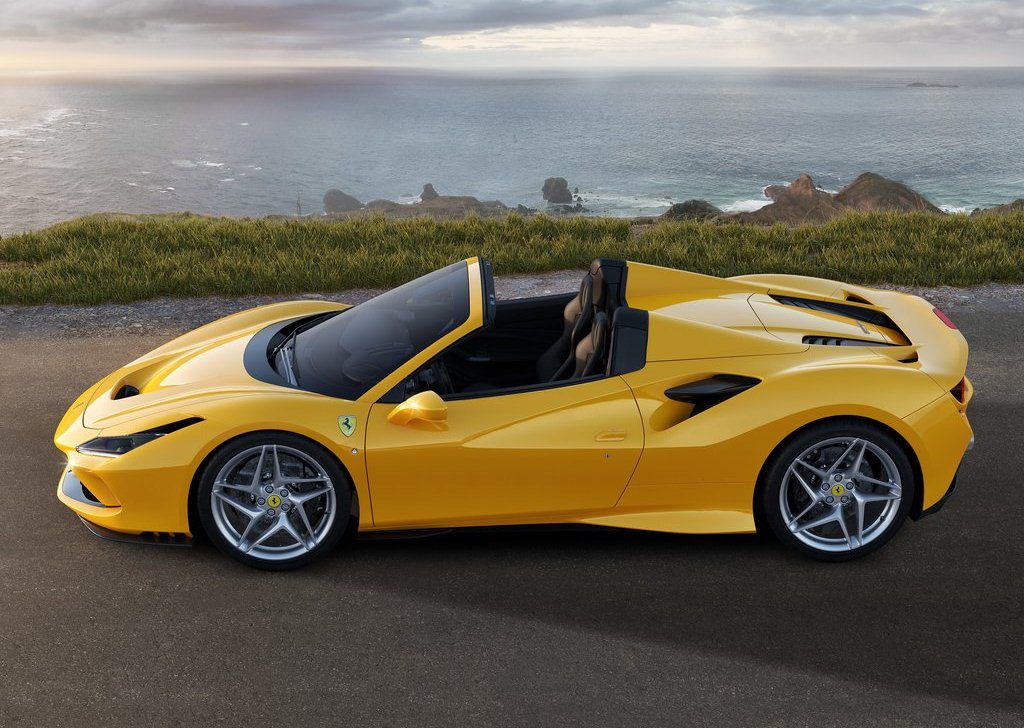Ferrari has unveiled the F8 Spider, the new generation drop-top sports car equipped with the most successful mid-rear-mounted V8 in history. The Ferrari F8 Spider was designed in parallel with the F8 Tributo berlinetta and features the Prancing Horse's compact and efficient RHT (Retractable Hard Top) which influences the lines of a model that leads its category. The Ferrari F8 Spider is the latest addition to an exclusive and prestigious bloodline of open-top V8 cars begun with the 308 GTS in 1977. It is less extreme than the 488 Pista Spider, but sportier than the 488 Spider which it replaces in the range. Consequently, the F8 Spider sets a new benchmark for the "en plein air" sports car in terms of usable performance and exceptional handling, providing an incredibly rewarding driving experience. In fact, it excels in merging handling dynamics with surprising in-car comfort. This Ferrari spider thus combines the characteristics of the most lauded 8-cylinder engine in history with unparalleled driving pleasure.
AERODYNAMICS
The F8 Spider has taken state-of-the-art aerodynamic solutions and innovations from Ferrari's GT and Challenge racing experience, and moulded them into the production mid-rear-engined drop-top that makes the highest level of performance accessible to drivers of all abilities. In the Ferrari F8 Spider, the position of the front radiators - which, unlike the 488 Spider, are rearward-angled - is beneficial in cooling terms but simultaneously shrinks the underbody surface area that can be used to generate downforce. Thus the geometry of the channels used to dissipate hot air had to be redesigned to ensure that maximum downforce was generated whilst cutting drag thanks to the positive interaction between the flows exiting the radiator and the front wheels. The result is a 10% improvement in the car's overall efficiency compared to the 488 Spider.
ENGINE
In the automotive world, Ferrari's V8 engine is seen as the very epitome of sportiness and driving pleasure. This is particularly the case when it is mid-rear-mounted in a two-seater. Ferrari has been honing the scope of this architecture to perfection for over four decades as it optimally balances weight for perfect handling dynamics.The V8's technical specifications are truly exceptional. The 3902 cc unit unleashes 720 cv at 8,000 rpm and also has an impressive specific power output of 185 cv/l. Its maximum torque is now higher at all engine speeds, peaking at 770 Nm at 3,250 rpm. Today, Ferrari V8s incorporate solutions so refined they are effectively masterpieces of engineering. This power unit in particular further enhances the typical traits of all Maranello engines with smoothly progressive, limitless acceleration and zero turbo lag, combined with a unique soundtrack courtesy of a new exhaust system. The new car offers drivers pure emotions. Instantaneously accessible power is matched by exceptional handling thanks to advanced vehicle dynamics solutions. These include a new version of the Ferrari Dynamic Enhancer (FDE+) which can now be activated in the manettino's RACE position, a move designed to make performance on the limit easier to reach and control.
DESIGN
Designed by the Ferrari Styling Centre, the F8 Spider continues the direction embarked upon with the F8 Tributo which acted as a bridge to a new design language that will continue to emphasise Ferrari's key characteristics of high performance and extreme aerodynamic efficiency. When designing a spider, the choice of the top will always play a fundamental role in the car's overall look. For some years now, Ferrari has been adopting a hard top because of the comfort it provides. As a result, the design of the Ferrari F8 Spider's lines was crafted around its RHT (Retractable Hard Top). The key to the whole design was the shifting of the separation line between the car's body and the roof from its conventional position at the belt-line (occupant shoulder level) to above the B-pillar. The top itself is thus more compact and two-dimensional, with the result that it can be divided into two parts and stowed on top of the engine. The RHT takes just 14 seconds to deploy or retract and can be closed or opened while the car is on the move up to 45 km/h.






![2026 Kia Sportage [EU] Review: A Refined European Crossover with Bold Style and Electrified Options](https://blogger.googleusercontent.com/img/b/R29vZ2xl/AVvXsEgqMRwJE1m90uCMgRSB6oc4bAzmAaKXJlNoCwavK5fXHaphLYY1sUVXdxUC94zuj95CdjDG2SqRnUBYMqta-dapTLIaHhzEdJAS821ldVMQOKfAZNpQlZ5fYTwKzKbKj8ad9QeKlaQPcNLRZ6zaGvuXhsg1kQ6zQCQqYtjmOM8q9u-a7Nl3WYjp773OLXJR/w680/2026%20Kia%20Sportage%20%5BEU%5D_01.jpg)













0 Comments